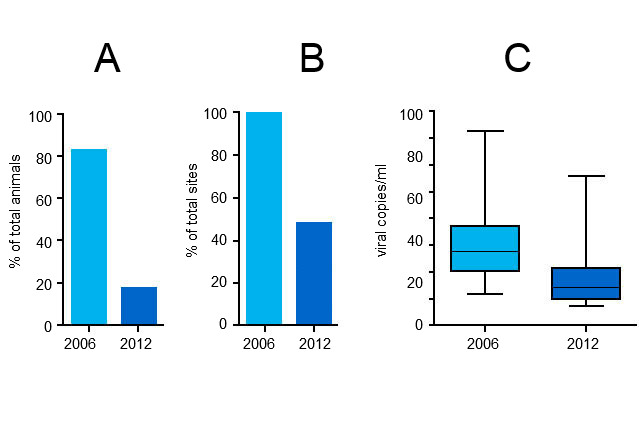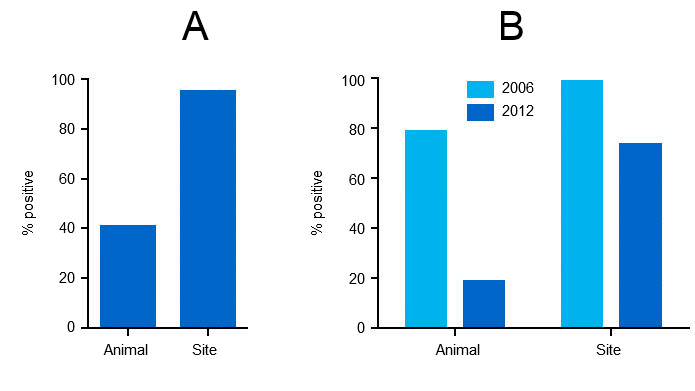Porcine circovirus type 2 (PCV2) is the causative agent of porcine circovirus associated disease (PCVAD), but requires additional factors for disease to manifest. PCV2 vaccines were introduced to the US in 2006, and were rapidly adopted throughout the swine industry to control PCVAD outbreaks. PCV2 vaccination is effective in preventing PCVAD, inducing high levels of anti-PCV2 antibodies and reducing the level of PCV2 in serum, but does not eliminate virus from the animal.
In 2006, prior to vaccine availability, biologic sampling in pig herds showed that high levels of PCV2 infection and serological responses were prevalent throughout the U.S. (Puvanendiran et al., 2011). Our lab also showed that infection was initiated in utero and in the farrowing room, leading to a life-long infection (Dvorak et al., 2013).

Since vaccination is nearly universal and successfully protects against PCVAD, we asked if viral loads had been reduced after 6 years of continuous vaccination and if high serologic responses were maintained. Thus, we examined serum samples from the U.S. National Animal Health Monitoring System’s survey of swine health to re-assess the infection and immune status of individual pigs as well as the swine farms.
Results
Serum samples were obtained and analyzed from 2044 individuals on 137 swine operations from 12 states throughout the US in 2012 and from 6046 individuals on 185 production sites in 16 states in 2006. All major swine-producing regions were included in both surveys.
The number of animals and sites that were infected with PCV2 was greatly reduced in 2012 (17.2% of individuals, 47.9% of sites infected) as compared to 2006 (82.6% of individuals, 99.5% of sites infected) (Figure 1A and B). A massive decrease in the amount of virus was also observed when comparing PCV2-positive animals from 2012 to those in 2006 (appx. 22-fold decrease in means and 49-fold decrease in maximal values) (Figure 1C).

Figure 1. PCV2 viremia levels in 2006 and 2012. A: Percent of viremic pigs in 2006 and 2012; B: percent of viremic finishing sites; and C: Viral levels in finishing pigs.

Figure 2. PCV2 antibodies in serum from finishing pigs in 2006 and 2012. A: Percent of anti-PCV2 antibody positive finishing pigs and sites (containing at least one PCV2 antibody positive pig) in 2012. B: The percent of animals and sites positive for anti-PCV2 antibodies induced by natural infection in 2006 and 2012.
Anti-PCV2 antibodies were detected in only 41% of finishing pigs in 2012, despite widespread vaccination (Figure 2A). However, on 94.9% of finisher sites at least one seropositive animal was observed (Figure 2A). Anti-PCV2 antibodies due to natural infection were greatly decreased in finishing pigs and on sites in 2012 (19.0% of pigs, 74% of sites) as compared to 2006 (79% of pigs, 99% of sites) (Figure 2B). In 2006 serological responses were all due to natural infection, since vaccine was not yet available. In 2012, serological responses were induced by both natural infection and vaccination. Natural infection was determined by the presence of antibodies to the viral replicase. Replicase is only produced by live virus; it is not present in PCV2 vaccines.
Conclusions
Since the introduction of highly effective PCV2 vaccines in 2006, viral presence and viral loads have decreased markedly in the swine population. Pigs today have lower viral loads, and virus is not detected by PCR on the majority of sites suggesting that continued vaccination has led to PCV2-negative herds over time. While the mechanism by which vaccination controls infection has not been resolved, its continued use is driving a dramatic reduction to below detectable levels for the prevalence of PCV2 in swine. At this time, we conclude that the majority of pigs remain infected with PCV2 at levels below the sensitivity limit of PCR, since more than 70% of sites contain animals with anti-replicase antibodies induced by natural infection. Infection also would account for anecdotal reports of porcine circovirus-associated disease in cases of vaccination lapses. Thus, vaccination continues to be important to protect animals against PCVAD.




